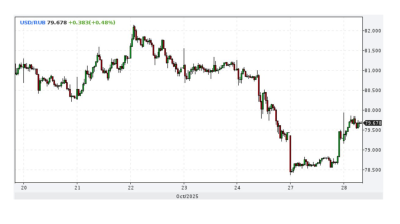Foreign investors piled into Ukraine’s local debt market since it was hooked up to Clearstream’s international payment and settlement system last March, but when emerging markets (EMs) around the world sold off heavily this February they found there were simply too many of them to leave all at once.
There was a noticeable sell-off on Ukraine’s domestic bond market after EMs were hit by a wave of selling at the end of February on the back of growing concerns over oil prices and the appearance of the coronavirus (COVID-19) in Asia.
The bond market hit its peak on St Valentine’s Day with a total of UAH809.4bn ($30bn) worth of bonds outstanding, of which foreign investors owned 15.7% - both all-time high records.
Its been an uncomfortable few months since then. Those investors were left holding unsafe Ukrainian debt that they couldn't dump and had become entirely hostage to Kyiv’s negotiations with the International Monetary Fund (IMF) to put a new $5bn standby agreement (SBA) deal in place.
This chapter in the story has a happy ending, as the IMF deal was done and bond yields returned to last year’s levels as the panic subsided. But since then there has been a steady stream of foreign investors leaving the market now the exit door is open again.
As of May 28, the total outstanding amount of Ukraine’s local bonds was as much as UAH883bn, but the foreign share of that was down at 11.9%. So far investors have already sold UAH21,8bn ($808mn) worth of bonds over the last three and half months.
Given the steady rate of the decline in the foreign holdings since the peak in February, bond traders look like they will continue to gradually unwind at least part of their exposure in the short term.
Bond revolution
Of all the reforms that have been made in since the Euromaidan protests in 2014, probably the most significant has been to hook Ukraine’s domestic debt market up to Clearstream in March 2019. That allowed Ukraine to tap a new and enormous pool of funds to finance its transformation and foreign investors poured some $5bn into the market last year. On the flip side, international bond traders were happy to be able tap the high yielding Ukrainian fixed income instruments and the positive newsflow coming out of Kyiv as Volodymyr Zelenskiy topped the polls ahead of the April presidential election.
The access to this new source of money transformed the government’s ability to fund itself and now the domestic market has become a boon, as it is a second line of defence as the government attempts to fund a massively increased deficit to counter the coronavirus (COVID-19) crisis.
Ukraine’s budget deficit was UAH23.5bn ($870mn) in January-April 2020, including the deficit of the general fund of UAH33bn, according to the preliminary estimates of the Finance Ministry on May 6.
"The national budget raised UAH73.8bn from the placement of government domestic loan bonds (97% of the target), including UAH41.3bn from the placement of foreign currency-pegged bonds ($1.2bn and €0.3bn). Some UAH34.2bn was raised from external sources (66% of the target), in particular, UAH33.9 via the placement of 10-year, €1.25bn Eurobonds at 4.375% per annum," the ministry said.
Ukraine needs to borrow the hryvnia equivalent of $17bn in total, Minister Marchenko told NV.ua in a lengthy interview. He calculates Ukraine will receive about one third of that in soft loans from international financial institutions. Most of the rest will come through rolling over existing domestic debt and selling new hryvnia bonds on the domestic market. Although yields on Ukraine’s sovereign bonds have receded to pre-crisis levels again, Marchenko said he wants to avoid placing new Eurobonds during the second half of this year if possible, as international borrowing remains very expensive.
The problem is that thanks to the coronavirus crisis, the government is going to have to spend way more money than it was expecting to have to only a few months ago.
The Ukrainian government has revised its projected budget deficit for 2020 up from an IMF-compliant 2% of GDP to a radical 7.5% of GDP to pay for countercyclical measures to deal with the economic shocks. The new parameters have already been agreed with the IMF, Marchenko said in April. The revised budget also envisages the economy shrinking by 4.8% due to the coronavirus pandemic, according to the Economics Ministry.
Marchenko says Ukraine needs to borrow a total of UAH457bn ($16.9bn) in 2020 both on the local and international markets. If the state can place a $4bn Eurobond on international capital markets and it is counting on some $8bn of loans from the international financial institutions (IFIs), that leaves the MinFin with some $5bn of fresh debt to raise on the domestic market, which is on a par with what was raised last year from foreigners (and doesn't count the amount of domestic debt that has to be raised to roll over the existing, mostly short-term, debt that will mature over the course of the year.)
"By the end of the year, we need to borrow about UAH457bn, but this amount includes both internal and external borrowings. We plan to re-issue internal loans, to make the so-called rollover. I do not see any problem of reissuing domestic debts. As for external debts, we are trying to finalise our programme with the IMF and reach out to the board in the near future. This will allow us to receive about $3.5bn from the IMF this year, plus this will unblock World Bank funding of up to $1bn. It will also help us receive €500mn of macro-financial assistance from the EU, which has already been announced, and €1.2bn, which we can receive additionally," Marchenko said.
So far foreign investors have been willing participants, but that might have changed now. At its most recent auction this week the ministry only raised UAH1bn ($40mn), which is a pittance compared to what the weekly auction usually brings in. The week before, the ministry issued twenty times more and the auctions before that brought in even larger amounts of money.
Analysts are still not sure if this week’s meagre take was simply a blip or the start of a more serious new trend.
Since the end of February foreign investors have drawn back from the local bond market after they had a nasty shock. As EM capital markets around the world sold off the bond investors realised there were simply too many of them for them all to exit the market at once. Despite the rapid advances the market has made in the last year, liquidity is limited and there were simply no buyers for Ukrainian debt in March.
While the new deal with the IMF signed in May has brought yields down and rekindled interest from international investors (and relief for those that were stuck holding Ukrainian debt), MinFin really needs to maintain its borrowing from the domestic market this year. Analysts say yields will have to rise if they are going bring in enough money.
-
 This article is from bne IntelliNews Ukraine monthly country report. Sign up to receive the report to your inbox each month, which covers the slow moving macro- and micro-economic trends, the major political news and a round up of the main sectors and corporate news. First month is free and you can unsubscribe at anytime.
This article is from bne IntelliNews Ukraine monthly country report. Sign up to receive the report to your inbox each month, which covers the slow moving macro- and micro-economic trends, the major political news and a round up of the main sectors and corporate news. First month is free and you can unsubscribe at anytime.
See a sample here.
Subscribe here (first month is free and you can unsubscribe at any time)
Or ask bne IntelliNews’s Stephen Vanson for a trial and corporate packages.
The report covers:
- macroeconomic trends and the real sector
- banking and finance
- public and external sector
- sector and leading corporate news
Or sign up to a trial by simply clicking on the button below. The first month is free and you can unsubscribe at anytime by sending an email to sales@intellinews.com
Sample:
http://online.flipbuilder.com/myab/dopo/
Order form:
https://to989.infusionsoft.com/app/orderForms/SUBOF-Country-Report-Ukraine-monthly
Features

CEE needs a new growth model as FDI plunges
wiiw economist Richard Grieveson says the CEE region’s long-standing model of attracting FDI through low labour costs no longer works.
KSE: Ukraine is facing a $53bn budget shortfall, but economy is stable for now
Ukraine is in urgent need of additional financing from partners as the continuation of the war drives up defence spending and reconstruction needs, jeopardizes budget financing, weighs on the balance of payments, and slows economic growth.

PANNIER: Ruling family’s ‘palace in the sky’ cruel sight for Turkmenistan’s poor souls down below
Photos posted of renovated Boeing by US makeover manager offer further insight into "ultra-luxurious" world enjoyed by Berdimuhamedovs.

Russia tax service targets Russian accounts in UAE
The Russian Federal Tax Service (FTS) has ramped up its scrutiny of Russian nationals holding accounts in the United Arab Emirates, following the effective implementation of automatic tax information exchange between the two countries.




